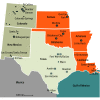Association of Texas' 2021 Ban on Abortion in Early Pregnancy With the Number of Facility-Based Abortions in Texas and Surrounding States
- PMID: 36318197
- PMCID: PMC9627516
- DOI: 10.1001/jama.2022.20423
Association of Texas' 2021 Ban on Abortion in Early Pregnancy With the Number of Facility-Based Abortions in Texas and Surrounding States
Abstract
Importance: Texas' 2021 ban on abortion in early pregnancy may demonstrate how patterns of abortion might change following the US Supreme Court's June 2022 decision overturning Roe v Wade.
Objective: To assess changes in the number of abortions and changes in the percentage of out-of-state abortions among Texas residents performed at 12 or more weeks of gestation in the first 6 months following implementation of Texas Senate Bill 8 (SB 8), which prohibited abortions after detection of embryonic cardiac activity.
Design, setting, and participants: Retrospective study of a sample of 50 Texas and out-of-state abortion facilities using an interrupted time series analysis to assess changes in the number of abortions, and Poisson regression to assess changes in abortions at 12 or more weeks of gestation. Data included 68 820 Texas facility-based abortions and 11 287 out-of-state abortions among Texas residents during the study period from September 1, 2020, to February 28, 2022.
Exposures: Abortion care obtained after (September 2021-February 2022) vs before (September 2020-August 2021) implementation of SB 8.
Main outcomes and measures: Primary outcomes were changes in the number of facility-based abortions for Texas residents, in Texas and out of state, in the month after implementation of SB 8 compared with the month before. The secondary outcome was the change in the percentage of out-of-state abortions among Texas residents obtained at 12 or more weeks of gestation during the 6-month period after the law's implementation.
Results: Between September 2020 and August 2021, there were 55 018 abortions in Texas and 2547 out-of-state abortions among Texas residents. During the 6 months after SB 8, there were 13 802 abortions in Texas and 8740 out-of-state abortions among Texas residents. Compared with the month before implementation of SB 8, the number of Texas facility-based abortions significantly decreased from 5451 to 2169 (difference, -3282 [95% CI, -3171 to -3396]; incidence rate ratio [IRR], 0.43 [95% CI, 0.36-0.51]) in the month after SB 8 was implemented. The number of out-of-state abortions among Texas residents significantly increased from 222 to 1332 (difference, 1110 [95% CI, 1047-1177]; IRR, 5.38 [95% CI, 4.19-6.91]). Overall, the total documented number of Texas facility-based and out-of-state abortions among Texas residents significantly decreased from 5673 to 3501 (absolute change, -2172 [95% CI, -2083 to -2265]; IRR, 0.67 [95% CI, 0.56-0.79]) in the first month after SB 8 was implemented compared with the previous month. Out-of-state abortions among Texas residents obtained at 12 or more weeks of gestation increased from 17.1% (221/1291) to 31.0% (399/1289) (difference, 178 [95% CI, 153-206]) during the period between September 2021 and February 2022 (P < .001 for trend).
Conclusions and relevance: Among a sample of abortion facilities, the 2021 Texas law banning abortion in early pregnancy (SB 8) was significantly associated with a decrease in the documented total of facility-based abortions in Texas and obtained by Texas residents in surrounding states in the first month after implementation compared with the previous month. Over the 6 months following SB 8 implementation, the percentage of out-of-state abortions among Texas residents obtained at 12 or more weeks of gestation significantly increased.
Conflict of interest statement
Figures



Comment in
-
Abortion bans and their impacts: A view from the United States.Cell Rep Med. 2023 Jan 17;4(1):100905. doi: 10.1016/j.xcrm.2022.100905. Cell Rep Med. 2023. PMID: 36652914 Free PMC article.
Comment on
-
The A Word-Our Collective Scarlet Letter.JAMA Surg. 2023 Feb 1;158(2):116-118. doi: 10.1001/jamasurg.2022.6638. JAMA Surg. 2023. PMID: 36318202 No abstract available.
References
-
- Relating to Abortion, Including Abortions after Detection of an Unborn Child’s Heartbeat; Authorizing a Private Civil Right of Action, SB 8, 87th Leg (Texas 2021-2022). May 19, 2021. Accessed June 23, 2022. https://legiscan.com/TX/text/SB8/2021
-
- Bohra N. Texas law banning abortion as early as six weeks goes into effect as the US Supreme Court takes no action. The Texas Tribune. Published August 31, 2021. Accessed August 17, 2022. https://www.texastribune.org/2021/08/31/texas-abortion-law-supreme-court/
-
- Human Life Protection Act, 2021, HB 1280 (Texas 2021). June 16, 2021. Accessed June 23, 2022. https://capitol.texas.gov/tlodocs/87R/billtext/html/HB01280F.htm
-
- White K, Vizcarra E, Palomares L, et al. . Initial impacts of Texas’ Senate Bill 8 on abortions in Texas and at out-of-state facilities. Texas Policy Evaluation Project. October 2021. Accessed August 17, 2022. http://sites.utexas.edu/txpep/files/2021/11/TxPEP-brief-SB8-inital-impac...
-
- White K, Dane’el A, Vizcarra E, et al. . Out-of-state travel for abortion following implementation of Texas Senate Bill 8. Texas Policy Evaluation Project. March 2022. Accessed April 28, 2022. http://sites.utexas.edu/txpep/files/2022/03/TxPEP-out-of-state-SB8.pdf
Publication types
MeSH terms
Grants and funding
LinkOut - more resources
Full Text Sources
Medical

